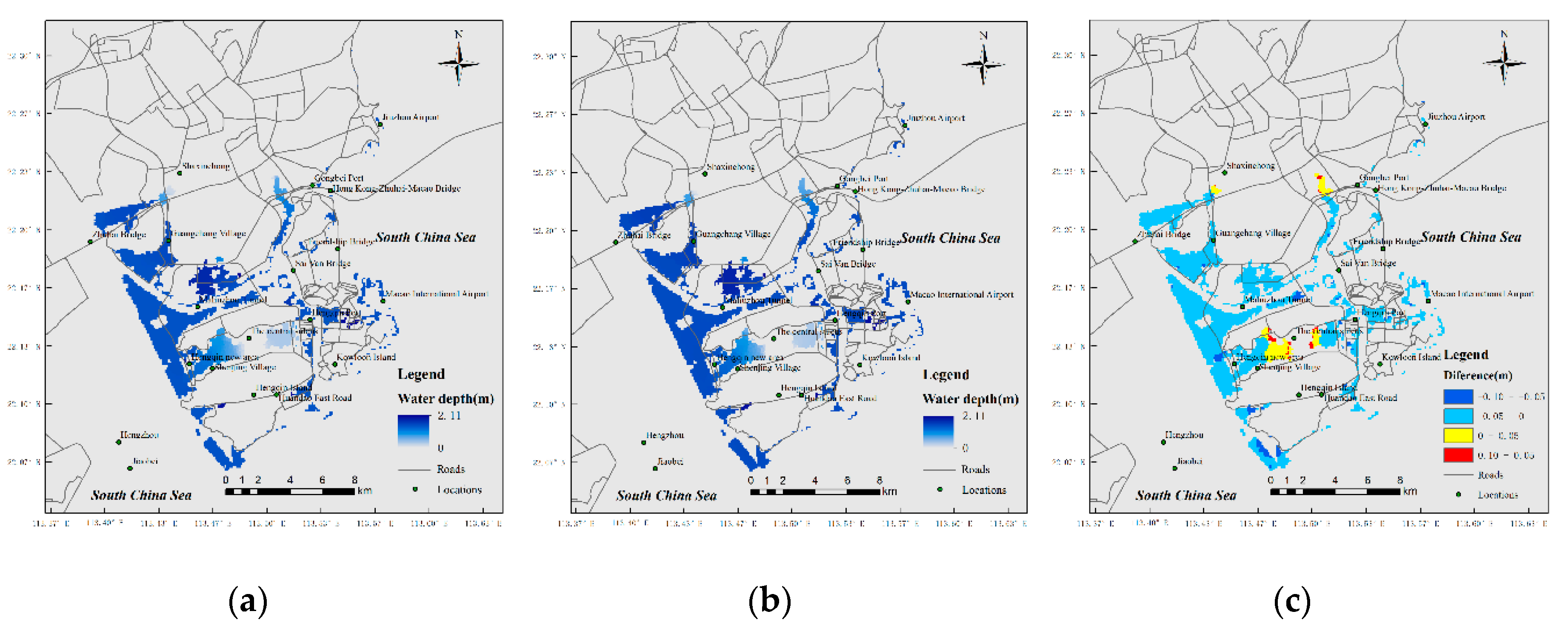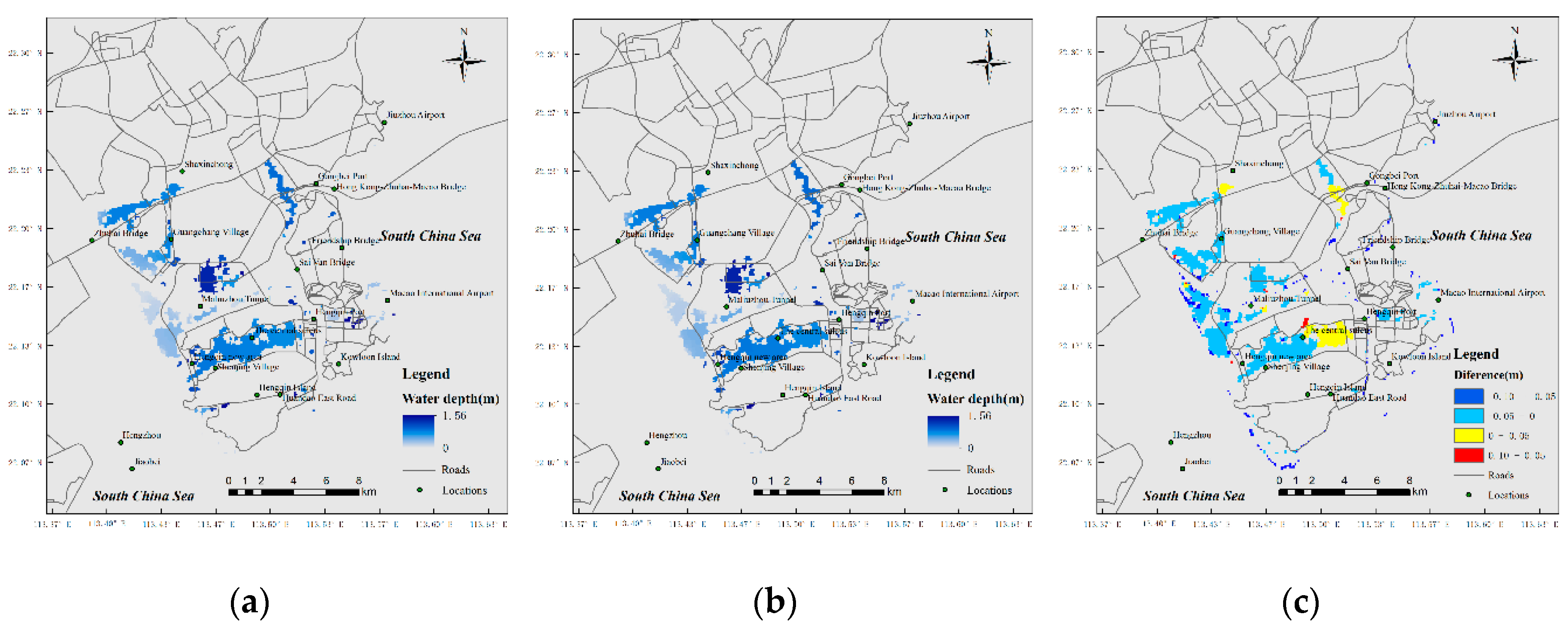An Integrated Approach for the Simulation Modeling and Risk Assessment of Coastal Flooding
Abstract
1. Introduction
2. Model Testing Materials and Methods
2.1. Case Background
2.2. Initial and Boundary Conditions for Model Testing
2.3. Methodology
2.3.1. Simplified Two-Dimensional Shallow Hydrodynamic Module
2.3.2. Physically-Based and Real-Time Risk Assessment Module
2.3.3. Calibration and Testing
3. Results and Discussions
3.1. Comparison with MIKE 21 Simulation Results
3.2. Comparison of CA Model with Social Media-Based Dataset
3.3. Coastal Flood Risk Assessment
4. Conclusions
Author Contributions
Funding
Conflicts of Interest
References
- Hallegatte, S.; Green, C.; Nicholls, R.; Corfee-Morlot, J. Future flood losses in major coastal cities. Nat. Clim. Chang. 2013, 3, 802–806. [Google Scholar] [CrossRef]
- Burrus, R.; Dumas, C.; Graham, J. Hurricane risk and coastal property owner choices. Int. J. Disaster. Resil. Built. Environ. 2011, 2, 118–138. [Google Scholar] [CrossRef]
- Klerk, W.J.; Winsemius, H.C.; Van Verseveld, W.J.; Bakker, A.M.R.; Diermanse, F.L.M. The co-incidence of storm surges and extreme discharges within the Rhine–Meuse Delta. Environ. Res. Lett. 2015, 10, 035005. [Google Scholar] [CrossRef]
- Vousdoukas, M.; Voukouvalas, E.; Annunziato, A.; Giardino, A.; Feyen, L. Projections of extreme storm surge levels along Europe. Clim. Dyn. 2016, 47, 3171–3190. [Google Scholar] [CrossRef]
- Androulidakis, Y.; Kombiadou, K.; Makris, C.; Baltikas, V.; Krestenitis, Y. Storm surges in the mediterranean sea: Variability and trends under future climatic conditions. Dyn. Atmos. Oceans. 2015, 71, 56–82. [Google Scholar] [CrossRef]
- Lin, N.; Emanuel, K. Grey swan tropical cyclones. Nat. Clim. Chang. 2015, 6, 106–111. [Google Scholar] [CrossRef]
- Schubert, C.E.; Busciolano, R.J.; Hearn, P.P.; Rahav, A.N.; Behrens, R.; Finkelstein, J.S.; Monti, J.; Simonson, A.E. Analysis of storm-tide impacts from Hurricane Sandy in New York. Available online: https://pubs.er.usgs.gov/publication/sir20155036 (accessed on 26 September 2019).
- Poulter, B.; Halpin, P. Raster modelling of coastal flooding from sea-level rise. Int. J. Geogr. Inf. Sci. 2008, 22, 167–182. [Google Scholar] [CrossRef]
- Lichter, M.; Felsenstein, D. Assessing the costs of sea-level rise and extreme flooding at the local level: A GIS-based approach. Ocean Coastal Manag. 2012, 59, 47–62. [Google Scholar] [CrossRef]
- Aerts, J.; Lin, N.; Botzen, W.; Emanuel, K.; de Moel, H. Low-probability flood risk modeling for New York City. Risk Anal. 2013, 33, 772–788. [Google Scholar] [CrossRef]
- Lloyd, S.; Kovats, R.; Chalabi, Z.; Brown, S.; Nicholls, R. Modelling the influences of climate change-associated sea-level rise and socioeconomic development on future storm surge mortality. Clim. Chang. 2015, 134, 441–455. [Google Scholar] [CrossRef]
- Gallien, T.; Schubert, J.; Sanders, B. Predicting tidal flooding of urbanized embayments: A modeling framework and data requirements. Coast. Eng. 2011, 58, 567–577. [Google Scholar] [CrossRef]
- Ramirez, J.; Lichter, M.; Coulthard, T.; Skinner, C. Hyper-resolution mapping of regional storm surge and tide flooding: Comparison of static and dynamic models. Nat. Hazards. 2016, 82, 571–590. [Google Scholar] [CrossRef]
- Bates, P.; Horritt, M.; Fewtrell, T. A simple inertial formulation of the shallow water equations for efficient two-dimensional flood inundation modelling. J. Hydrol. 2010, 387, 33–45. [Google Scholar] [CrossRef]
- Patro, S.; Chatterjee, C.; Mohanty, S.; Singh, R.; Raghuwanshi, N. Flood inundation modeling using MIKE FLOOD and remote sensing data. J. Indian Soc. Remote Sens. 2009, 37, 107–118. [Google Scholar] [CrossRef]
- Xia, J.; Guo, P.; Zhou, M.; Falconer, R.; Wang, Z.; Chen, Q. Modelling of flood risks to people and property in a flood diversion zone. J. Zhejiang Univ.-Sci. A 2018, 19, 864–877. [Google Scholar] [CrossRef]
- Prakash, M.; Rothauge, K.; Cleary, P. Modelling the impact of dam failure scenarios on flood inundation using SPH. Appl. Math. Model. 2014, 38, 5515–5534. [Google Scholar] [CrossRef]
- Vacondio, R.; Rogers, B.; Stansby, P.; Mignosa, P. SPH modeling of shallow flow with open boundaries for practical flood simulation. J. Hydraul. Eng.-ASCE 2012, 138, 530–541. [Google Scholar] [CrossRef]
- Wang, X.; Sun, X.; Zhang, S.; Sun, R.; Li, R.; Zhu, Z. 3D simulation of storm surge disaster based on scenario analysis. Trans. Tianjin Univ. 2016, 22, 110–120. [Google Scholar] [CrossRef]
- A State of the Art Review on Mathematical Modelling of Flood Propagation. Available online: http://www.impact-project.net/cd/papers/print/008_pr_02-05-16_IMPACT_Alcrudo.pdf (accessed on 30 May 2020).
- McLusky, D.; Wolanski, E. Treatise on Estuarine and Coastal Science; Academic Press: Amsterdam, The Netherlands, 2011; pp. 441–458. [Google Scholar]
- Warren, I.; Bach, H. MIKE 21: A modelling system for estuaries, coastal waters and seas. Environ. Softw. 1992, 7, 229–240. [Google Scholar] [CrossRef]
- Madsen, H.; Jakobsen, F. Cyclone induced storm surge and flood forecasting in the northern Bay of Bengal. Coast. Eng. 2004, 51, 277–296. [Google Scholar] [CrossRef]
- Wang, J.; Gao, W.; Xu, S.; Yu, L. Evaluation of the combined risk of sea level rise, land subsidence, and storm surges on the coastal areas of Shanghai, China. Clim. Chang. 2012, 115, 537–558. [Google Scholar] [CrossRef]
- Wolfram, S. Computation theory of cellular automata. Commun. Math. Phys. 1984, 96, 15–57. [Google Scholar] [CrossRef]
- Zhou, C.; Sun, Z.; Xie, Y. Research of Geographical Cellular Automata; Science Press: Beijing, China, 1999. (In Chinese) [Google Scholar]
- Murray, A.; Paola, C. A cellular model of braided rivers. Nature 1994, 371, 54–57. [Google Scholar] [CrossRef]
- Folino, G.; Mendicino, G.; Senatore, A.; Spezzano, G.; Straface, S. A model based on cellular automata for the parallel simulation of 3D unsaturated flow. Parallel Comput. 2006, 32, 357–376. [Google Scholar] [CrossRef]
- Mendicino, G.; Senatore, A.; Spezzano, G.; Straface, S. Three-dimensional unsaturated flow modeling using cellular automata. Water Resour. Res. 2006, 42. [Google Scholar] [CrossRef]
- Cai, X.; Li, Y.; Wu, W.; Wang, Y. Cellular automaton model of flood submergence based on bulk method. J. Hydroelectric. Eng. 2013, 32, 30–34. (In Chinese) [Google Scholar]
- Li, Y.; Gong, J.; Zhu, J.; Song, Y.; Hu, Y.; Ye, L. Spatiotemporal simulation and risk analysis of dam-break flooding based on cellular automata. Int. J. Geogr. Inf. Sci. 2013, 27, 2043–2059. [Google Scholar] [CrossRef]
- Guidolin, M.; Chen, A.; Ghimire, B.; Keedwell, E.; Djordjević, S.; Savić, D. A weighted cellular automata 2D inundation model for rapid flood analysis. Environ. Modell. Softw. 2016, 84, 378–394. [Google Scholar] [CrossRef]
- Dottori, F.; Todini, E. Developments of a flood inundation model based on the cellular automata approach: Testing different methods to improve model performance. Phys. Chem. Earth 2011, 36, 266–280. [Google Scholar] [CrossRef]
- Parsons, J.; Fonstad, M. A cellular automata model of surface water flow. Hydrol. Process. 2007, 21, 2189–2195. [Google Scholar] [CrossRef]
- 2017 State Oceanic Administration. Available online: http://gc.mnr.gov.cn/201806/t20180619_1798021.html (accessed on 30 May 2020).
- White, R.; Engelen, G. High resolution integrated modeling of the spatial dynamics of urban and regional systems. Comput. Environ. Urban Syst. 2000, 24, 383–400. [Google Scholar] [CrossRef]
- Li, X. Geographic Simulation System: Cellular Automata and Multi-Agent; Science Press: Beijing, China, 2007. (In Chinese) [Google Scholar]
- Liu, S.K.; Li, X.; Li, S.; Yu, T. Numerical simulation of flood routing in Xiaoqinghe plain. Shuikexue Jinzhan 1991, 2, 188–193. (In Chinese) [Google Scholar]
- Merz, B.; Kreibich, H.; Schwarze, R.; Thieken, A. Review Article “Assessment of economic flood damage”. Nat. Hazards Earth Syst. Sci. 2010, 10, 1697–1724. [Google Scholar] [CrossRef]
- Wei, Y.M.; Jin, J.L.; Yang, C.J.; Huang, S.F.; Fan, Y.; Chen, D.Q. Theory of Risk Management of Flood Disaster; Science Press: Beijing, China, 2020. (In Chinese) [Google Scholar]
- Yang, T.; Xie, J.; Li, G. A Social Media-based Dataset of Typhoon Disasters. 2017. Available online: http://www.scidb.cn/detail?dataSetId=633694461024534528&language=zh_CN&dataSetType=journal (accessed on 14 April 2020).













| Land Use | Mean | SD | Loss Rate Corresponding to Different Water Depths (%) | ||||
|---|---|---|---|---|---|---|---|
| (CNY/m2) | (CNY/m2) | 0–0.5 | 0.5–1.0 | 1.0–1.5 | 1.5–2.0 | >2.5 | |
| Cropland | 10.38 | 2.46 | 15 | 25 | 50 | 80 | 100 |
| Water | 21.97 | 4.54 | 1 | 2 | 3 | 5 | 7 |
| Forest | 0.88 | 0.23 | 2 | 5 | 10 | 15 | 25 |
| Building area | 5078.67 | 1267.44 | 8 | 12 | 17 | 22 | 27 |
| Development area | 646.94 | 150.89 | 3 | 7 | 10 | 14 | 21 |
| Statistical Parameter | Resolution (m) | ||||
|---|---|---|---|---|---|
| 10 | 25 | 50 | 100 | 200 | |
| RMSE (m) | 0.02 | 0.03 | 0.03 | 0.04 | 0.05 |
| R | 0.93 | 0.94 | 0.95 | 0.95 | 0.93 |
| Resolution (m) | ||||||
|---|---|---|---|---|---|---|
| 10 | 25 | 50 | 100 | 200 | ||
| Simulation Time (min) | MIKE | 37.02 | 10.35 | 3.27 | 2.60 | 1.98 |
| CA | 3.58 | 2.31 | 1.23 | 0.71 | 0.50 | |
| Collection Channel | Number of Photos | |||||
|---|---|---|---|---|---|---|
| Total | Correct | |||||
| 10 m | 25 m | 50 m | 100 m | 200 m | ||
| Sina-Weibo | 50 | 49 | 49 | 49 | 49 | 49 |
| 50 | 49 | 49 | 49 | 48 | 48 | |
| Baidu | 50 | 48 | 48 | 48 | 48 | 48 |
| Water Depth (m) | Cropland | Water | Forest | Building Area | Development Area | |||||
|---|---|---|---|---|---|---|---|---|---|---|
| Area (km2) | Loss (104 CNY) | Area (km2) | Loss (104 CNY) | Area (km2) | Loss (104 CNY) | Area (km2) | Loss (108 CNY) | Area (km2) | Loss (108 CNY) | |
| 0–0.5 | 0.33 | 51.38 | 9.95 | 218.60 | 0.58 | 1.02 | 3.34 | 13.57 | 1.66 | 0.32 |
| 0.5–1.0 | 0.44 | 114.18 | 7.69 | 337.90 | 0.55 | 2.42 | 3.16 | 19.26 | 1.98 | 0.90 |
| 1.0–1.5 | 0.35 | 181.65 | 5.06 | 333.50 | 1.32 | 11.62 | 2.31 | 19.95 | 2.41 | 1.56 |
| 1.5–2.0 | 0.33 | 274.03 | 3.63 | 398.76 | 1.45 | 19.14 | 1.55 | 17.32 | 2.94 | 2.66 |
| 2.0–2.5 | 0.33 | 342.54 | 5.43 | 835.08 | 1.34 | 29.48 | 2.00 | 27.43 | 6.50 | 8.83 |
| Total | 1.78 | 963.78 | 31.76 | 2123.84 | 5.24 | 63.68 | 12.36 | 97.53 | 15.49 | 14.27 |
© 2020 by the authors. Licensee MDPI, Basel, Switzerland. This article is an open access article distributed under the terms and conditions of the Creative Commons Attribution (CC BY) license (http://creativecommons.org/licenses/by/4.0/).
Share and Cite
Zheng, Y.; Sun, H. An Integrated Approach for the Simulation Modeling and Risk Assessment of Coastal Flooding. Water 2020, 12, 2076. https://doi.org/10.3390/w12082076
Zheng Y, Sun H. An Integrated Approach for the Simulation Modeling and Risk Assessment of Coastal Flooding. Water. 2020; 12(8):2076. https://doi.org/10.3390/w12082076
Chicago/Turabian StyleZheng, Yazhi, and Hai Sun. 2020. "An Integrated Approach for the Simulation Modeling and Risk Assessment of Coastal Flooding" Water 12, no. 8: 2076. https://doi.org/10.3390/w12082076
APA StyleZheng, Y., & Sun, H. (2020). An Integrated Approach for the Simulation Modeling and Risk Assessment of Coastal Flooding. Water, 12(8), 2076. https://doi.org/10.3390/w12082076






